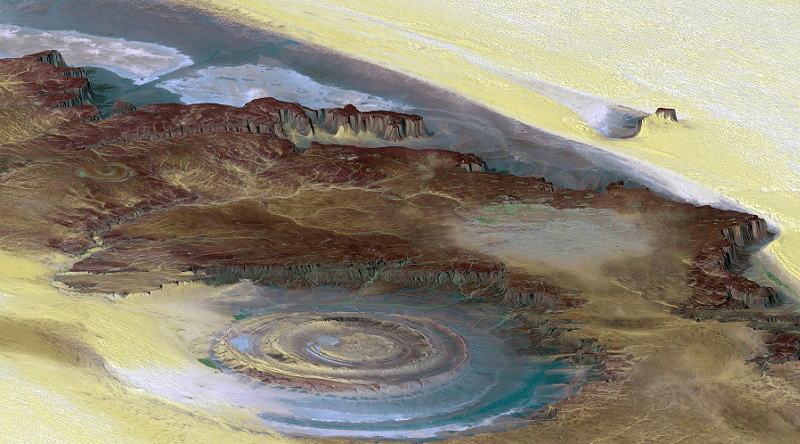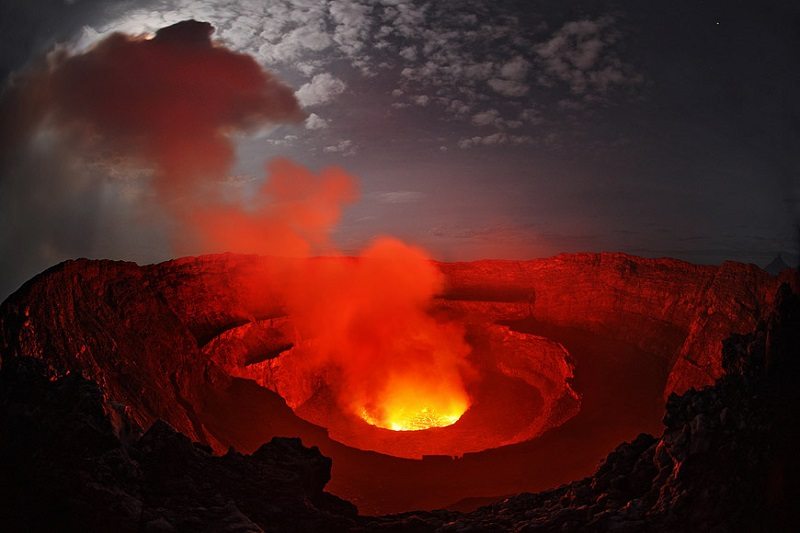 Source: https://bit.ly/3dv8Cev Public Domain Image
Source: https://bit.ly/3dv8Cev Public Domain Image
Nyiragongo Volcano Facts
- This astonishing creation of geological processes bears the somewhat hard to pronounce name of Nyiragongo Volcano. It’s perhaps best known, at least to researchers, for its utterly unique combination of factors. Vulcanologists therefore continue to study it even today.
- In fact, those ongoing investigations keep a multitude of geologists, vulcanologists, and even those specializing in related fields busy. That’s mainly due to the extreme variability of conditions in and around its confines. While fascinating, this also remains dangerous.
- The breathtaking site also stands out from similar formations around the world. It further does so for a variety of reasons. Perhaps chief among these stands its sheer volume. While this naturally varies, the average amount of lava contained within it staggers the imagination.
- More precisely, the average amount of molten rock that’s contained inside makes it the largest regularly maintained lava lake in the world. The lava produced by this volcano additionally garners much interest, and thus study, due to its intriguing and highly unusual nature.
- That’s true since that material produced by the magnificent Nyiragongo Volcano possesses an extremely fluid consistency. This occurs due to its containing an unusually high concentration of alkali-rich volcanic rock. That nature creates a remarkable effect on its eruptions.
- Coincidentally, this impressive volcano also possesses a relatively steep slope. Its flows often literally do flow, almost like water. Combined with the fluid consistency of that lava and its proximity to populated areas, it’s viewed as a highly dangerous cration of geological forces.
Related Places



Nyiragongo Volcano Physical Description
The fabulous Nyiragongo Volcano represents an excellent example of the specific variety that experts in the field classify as a stratovolcano. That’s one displaying a roughly conical shape, that’s also formed of multiple layers of hardened lava and debris, professionally known as tephra.
This wonder of vulcanism also remains highly active in nature, and indeed, remains in that state almost constantly. This serves to make it one of the few of its type in the world for which this holds true. Its precise shape and dimensions are therefore constantly changing, at least to small degrees.
This leading, turbulent geological marvel of its region additionally boasts yet other impressive physical statistics. It stands quite tall, with a height equaling roughly 11,380 ft (3,470 m). The primary crater itself also stands out for its phenomenal size, measuring almost 1.25 mi (2 km) in width.
The ever-present lava lake of the Nyiragongo Volcano adds yet another distinctive characteristic to the already amazing site. That’s because this feature has an average depth of nearly 2,000 ft (600 m). Yet the nature of the lava itself is the most distinctive feature of this prodigious peak.
This has an extremely high alkali ratio, which allows for its flowing remarkably rapidly down its steep slopes. As a result, flow speeds sometimes even reach 60 mph (96 kph). Due to its specific combination of slope and lava fluidity, its flow speeds represent the fastest currently known to man.
Nyiragongo Volcano Location, Formation, and History
For the moment, vulcanologists still know little of this marvel’s ancient eruptive history. During its activity in modern times, though, events remains well documented. The volcano previously erupted at least 34 times since 1882. Incredibly, some of these eruptions lasted for years at a time.
It represents part of the western branch of the East African Rift System. Here, the African Plate continues to split into the Nubian Plate and the Somali Plate. As the plates pull apart, the Earth’s crust thins and fractures, allowing magma from the mantle to rise and form volcanoes.
This amazing volcano also has an amazing history all its own, however. It actually overlaps with several other volcanoes, even older, and sits amid hundreds of small cinder cones. Because of its extreme and unique dangers, the Nyiragongo Volcano was named as a Decade Volcano in 1991.
In March of 2016, the Goma Volcano Observatory discovered that a new vent had recently opened on the northeast edge of the crater. Since that time, various rumblings and small quakes have continued to occur within its confines. It’s by no means finished amazing the human race.
Features Sharing Its Region



Check out our other articles on 6 Captivating European Caves, Yeti Crab, Crab Eating Fox, Rhine Falls, Leaping Lesbian Lizard, Mount Bromo, Queen of the Andes, Hellbender Salamander











Leave a Reply